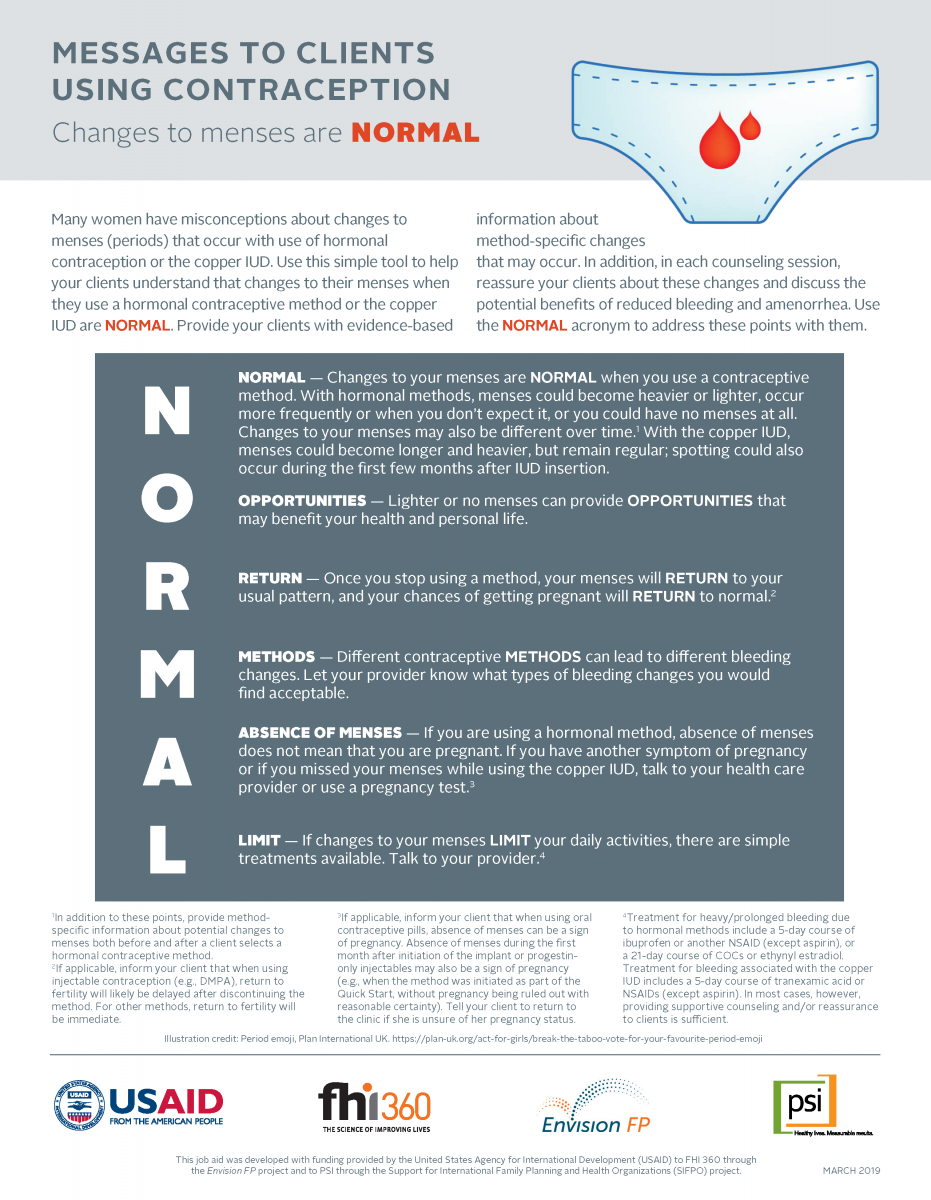It’s Time to NORMAL-ize Menstrual Bleeding Changes for Contraceptive Users

Frontline health workers can reassure women about the menstrual bleeding changes they are likely to experience when using contraception. The NORMAL tool provide simple guidance. Photo by Jessica Scranton.
By Kate H. Rademacher and Jill Sergison
Around the world, women often worry about the menstrual bleeding changes they experience when using contraception. This anxiety can be especially pronounced when their menses stop completely – a normal and safe phenomenon called “amenorrhea” – when using certain types of hormonal methods.
Frontline health workers play a key role in reassuring women about contraceptive-induced menstrual bleeding changes, including amenorrhea. They can also let women know that reduced or no bleeding can have both health and lifestyle benefits for girls and women. Because of the potential advantages of amenorrhea, we think it’s time to embrace and celebrate this potential “side effect” of contraception and re-frame it as a positive method attribute.
Recently, FHI 360 and PSI collaborated to develop a new job aid for health care providers, funded by the US Agency for International Development (USAID), to use when counseling women about the menstrual bleeding changes they are likely to experience when using family planning methods. This simple tool uses a mnemonic device – NORMAL – to remind providers to tell women that changes to menses are common and are not harmful to one’s health. Providers are also encouraged to emphasize that, for women using hormonal contraception consistently and correctly, absence of menses does not mean a woman is pregnant. Also, once a woman stops using a hormonal method, her menses and ability to get pregnant will return to what they were before she used the method.

Family planning provider in Abuja, Nigeria. The NORMAL tool was refined based on feedback from providers and reproductive health experts in Haiti, Nigeria, Zambia and elsewhere. Photo by Kate Rademacher.
After initial dissemination of the NORMAL tool, we are delighted that it has been enthusiastically embraced by both health providers and program managers. Based on initial feedback, we recently added a second side to the NORMAL tool (the complete tool can be downloaded for free here). The expanded version provides additional information about the menstrual bleeding changes that are common with different types of contraception and provides more explanation on how and why amenorrhea can be viewed as a positive method attribute. These points include:
- Not having menstrual bleeding or having reduced bleeding may help improve health conditions such as heavy or painful menses. Reduced or no bleeding may also help with anemia.
- Reduced bleeding or no bleeding can provide increased freedom to engage in work or school activities.
- Some contraceptives can give you options when it comes to managing your menses including the ability to intentionally skip or eliminate menstrual bleeding. Women should talk to their provider about their options.

An excerpt from the NORMAL tool.
May 28 is international Menstrual Hygiene Day. It is no accident that we are writing this blog about amenorrhea on a day that is intended to end period stigma and promote access to safe and effective menstrual hygiene management (MHM). We believe that helping girls and women have access to high quality contraceptive services – including family planning methods that induce amenorrhea – can help advance the global MHM agenda. Part of our vision for MHM is that girls and women will have the ability to safely manage their menses in a number of ways – including the option to reliably stop their menses – if that’s what they prefer.
So, today and every day, we encourage you to join us in helping normalize contraceptive-induced bleeding changes including amenorrhea.
About: Kate Rademacher and Jill Sergison work for FHI 360, an international nonprofit working to improve the health and well-being of people around the world. The work described in this blog was made possible by the generous support of the American people through the Envision FP project with funding from U.S. Agency for International Development (USAID). The content and views expressed by the authors in this publication do not necessarily reflect the views of USAID, the United States Government, FHI 360, or Population Services International.
